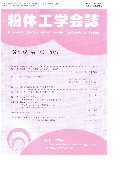All issues

Volume 48, Issue 10
Displaying 1-5 of 5 articles from this issue
- |<
- <
- 1
- >
- >|
-
Akira Kobayashi, Masaya Yoshida, Keishi Iizuka, Hidehiro Kamiya2011Volume 48Issue 10 Pages 686-691
Published: October 10, 2011
Released on J-STAGE: October 28, 2011
JOURNAL FREE ACCESSSpherical fused silica produced by flame fusion process has been used as a filler for epoxy molding compound to encapsulate electronic devices such as IC and semiconductors. By FE-SEM and TEM observation, a lot of silica nanoparticles adhere to the surface of spherical fused silica of several μm in diameter. The effect of surface treatment by using TEOS (tetra-ethyl-ortho- silicate) on the particle adhesive force was investigated by AFM and conventional tensile strength of powder bed. It was confirmed that particle adhesive force decreased after TEOS treatment by using both testing methods, and the specific surface area increased by the surface treatment. The relationship between the change of adhesion force after surface treatment with different condition and surface nanometer and molecular scaled structure of spherical fused silica was discussed. The decrease of adhesion force and increase of specific surface area of spherical fused silica after surface treatment were developed on the amount of residual functional etoxy group.View full abstractDownload PDF (934K) -
Yoshinori Yamada, Mikio Sakai, Shin Mizutani, Shinsuke Murakami, Chiha ...2011Volume 48Issue 10 Pages 692-700
Published: October 10, 2011
Released on J-STAGE: October 28, 2011
JOURNAL FREE ACCESSThe discrete element method (DEM) is well employed in computational granular dynamics. The DEM is a Lagrangian approach where individual particles are calculated based on the Newtons second law of motion. Hence, the DEM enables us to investigate the granular flow characteristics at the particle level. The calculated particle shape was often modeled to be spherical in the past studies. This is because the contact judgement is easy. The spherical particle shape often cause the difference between the simulation and experiment results. When the effect of the particle shape on the flowability cannot be neglected, the particle shape was modeled by meshes or cluster of calculated particles in the past studies. However, the calculation cost of these models became too expensive. As a result, these models could not be applied in large scale powder systems. To solve this issue we developed a DEM rotational resistance model in the previous study. The DEM rotational resistance model could simulate the actual particle whose shape was complicated, though the spherical particle was used in the simulation. On the other side, this model could not simulate the acctual recoiled particle behavior precisely. In the present study, this model is evolved by modeling the restitution. Numerical simulation and validation test were performed. The particle shape, namely, number of angles was decided based on the projected picture. Adequacy of this evolved model is validated through this study.View full abstractDownload PDF (1027K) -
Hiroshi Sato, Katsuyasu Sugawara2011Volume 48Issue 10 Pages 701-707
Published: October 10, 2011
Released on J-STAGE: October 28, 2011
JOURNAL FREE ACCESSIn order to determine the optimum fabrication condition of inorganic electroluminescence device by co-firing of multilayers consisted of phosphor ((Ca0.6Sr0.4)0.997Pr0.002)TiO3, dielectric materials BaTiO3, transparent electrode ITO and back electrode AgPd, sintering behavior of the layers and changes of chemical composition and electro-properties were investigated during calcination and co-firing. It was developed that the calcination temperature above 900°C was appropriate for the phosphor to suppress the crack and delamination caused by gas evolution and expansion during co-firing. Addition of phosphor material to BaTiO3 layer was an effective method to obtain the desired sintering behavior and electro-characteristics. The sintering behavior of BaTiO3 layer could be matched with that of phosphor layer, and dielectric constant was improved rather than BaTiO3 alone when BaTiO3 was mixed with phosphor with the volume ratio of 80 : 20. By co-firing at the temperatures of 800°C and 1100°C, the inorganic electro-luminescence device with the radiation of red light could be prepared.View full abstractDownload PDF (918K)
Review
-
Kazuhiro Mae2011Volume 48Issue 10 Pages 708-715
Published: October 10, 2011
Released on J-STAGE: November 03, 2015
JOURNAL RESTRICTED ACCESSMixing in micro space is categorized into two concepts : rapid mixing and precise diffusion control. In this paper, the methodology for designing nano-particles was summarized based on these mixing concepts. First, the processing logic for nucleation by micro mixer was discussed in light of the typical experimental result. On the other hand, it was shown that a precise diffusion control by designing a micro space had a significant effect for individual strict control of nucleation and particle growth processes. The results shown here clearly indicate that micro reactor technology will be a powerful tool for nano-processing.View full abstractDownload PDF (986K)
Review: Frontier Research Series
-
Takashi Ogi2011Volume 48Issue 10 Pages 716-723
Published: October 10, 2011
Released on J-STAGE: November 03, 2015
JOURNAL RESTRICTED ACCESSNanoparticles of noble metals can be applied to a wide range of functions such as catalysis, optics and biosensing. Although chemical and physical synthetic routes for the production of noble metal nanoparticles have been extensively developed, another possibility is biological methods in which micro-organisms are used to synthesize noble nanoparticles by reducing soluble metal ions in aqueous solutions. Microbial synthetic route to noble metal nanoparticles is potentially attractive as an environmentally friendly method because biological systems at room temperature and near-neutral pH involve low energy consumption and are environmentally safe. This paper reports the biosynthesis of Pd and Au nanoparticle, analysis of the oxidation states of biogenetic metal nanoparticle, control of particle size and morphology, and application of these biosynthesized metal nanoparticles as a catalyst.View full abstractDownload PDF (1318K)
- |<
- <
- 1
- >
- >|